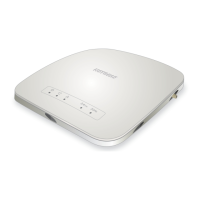Initial Setup
12
ProSAFE Dual-Band Wireless AC Access Points WAC720 and WAC730
• Away from large metal surfaces or water.
• Placing an external antenna in a vertical position provides best side-to-side coverage.
Placing an external antenna in a horizontal position provides best up-and-down
coverage. (An external antenna does not come standard with the wireless access point.)
If you are using multiple wireless access points, it is better if adjacent wireless access points
use different radio frequency channels to reduce interference. The recommended channel
spacing between adjacent wireless access points is five channels (for example, use
Channels 1 and 6, or 6 and 11, or 1 and 11).
The time it takes to establish a wireless connection can vary depending on both your security
settings and placement.
Ethernet Cabling Requirements
The wireless access point connects to your LAN using twisted-pair Category 5 Ethernet cable
with RJ-45 connectors.
LAN Configuration Requirements
For the initial configuration of your wireless access point, you must connect a computer to the
wireless access point.
Hardware Requirements for Computers on Your LAN
To connect to the wireless access point on your network, an 802.11bg/ng/bgn or
802.11a/a-na-ac wireless adapter must be installed on each computer. We recommend using
the wireless access point with computers with the NETGEAR A6210 WiFi USB Adapter
installed.
Operating Frequency Guidelines
You do not need to change the operating frequency (channel) unless you notice interference
problems or you place the wireless access point near another wireless access point. If you do
change the operating frequency, observe the following guidelines:
• Wireless access points use a fixed channel. You can select a channel that provides the
least interference and best performance. In the United States and Canada, 11 channels
are available.
• If you use multiple wireless access points, it is better if adjacent wireless access points
use different channels to reduce interference. The recommended channel spacing
between adjacent wireless access points is five channels (for example, use Channels 1
and 6, or 6 and 11).
• In infrastructure mode (which is the default mode for the wireless access point), wireless
stations normally scan all channels, looking for a wireless access point. If more than one
wireless access point can be used, the one with the strongest signal is used. This is
possible only if the wireless access points use the same SSID.

